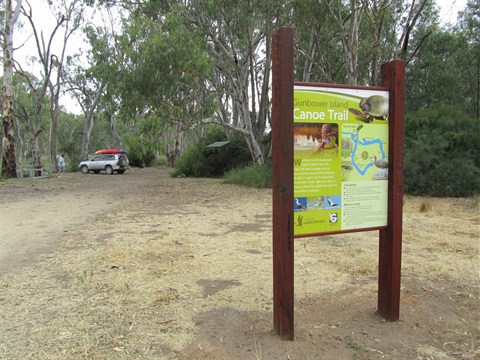Gunbower Island
Published on 21 December 2016

Gunbower Island Canoe Trail
The wetlands of Gunbower Island are a unique and diverse wonderland of water birds, wildlife and aquatic plants. They have been recognised as Wetlands of International significance by the RAMSAR Convention. Wetlands act as a filter for the water system ensuring a clean and consistent flow of nutrients throughout the system. From the smallest of insects or plant to the largest of the Red Gums, all parts of the wetland are essential in maintaining the diversity and richness of these waters.
Gunbower Island features two significant forest areas. The Gunbower State Forest is located to the north and accessible from Koondrook, while the Gunbower National Park is to the south and accessible from Cohuna.
The canoe trail on the Gunbower Creek is located south east of Koondrook in the beautiful Gunbower State Forest. The waters of the creek spread out to create Safes Lagoon which is an amazing wetland rich with aquatic plants, birds and animals.
The trail is a return route of approximately 5km and will take about 2 hours to complete. Yellow floating buoys markers indicate the trail.
The wetland is an environmental showpiece and if lucky you may see platypus in the tranquil waters. Birds such as sea eagles, ibis, spoonbills and herons can often be seen along with smaller kingfishers, parrots and swallows. A variety of freshwater turtles can be seen basking on logs or swimming gracefully through the reeds. Kangaroos are common feeding along the banks of the lagoon as are emus and small black wallabies.
The wetlands are also home to many native fish such as Murray Cod, Golden Perch (Yellowbelly) Silver Perch and native Australian Catfish. With its great stands of rushes and its tranquility, Safes Lagoon is a haven for breeding and nesting birds. These birds, with their great diversity, are the treasures of the wetlands, many coming from miles away to visit this amazing area.
In the forest you can see goannas over a metre long, lizards and snakes. Keep your eye out for the beautiful carpet python with its camouflage markings. This snake is endangered and it’s a lovely passive resident of the forest!
Trail Points of Interest
Before you begin to canoe, have a look at the dead trees that have a ring cut into the trunk about two feet up. These trees were ringbarked; a practice where the sapwood is severed to prevent nutrient flow up the tree. Starved of its nutritional source the tree gradually dies. These trees were ringbarked by forest workers in the late 1800’s and early to mid-1900’s. The trees selected for ringbarking were the largest of the forest, referred to as ‘Bull’ trees. They were killed to allow the new trees to grow more abundantly. The result was a denser forest, with smaller trees due to reduced competition for sunlight and nutrients. Many of these larger living trees are now recognised as valuable habitat for a variety of animals, and are protected.
Canoe Trees
You will notice some old trees with “scars” of various shapes and sizes cut out of the bark. This is referred to as a ‘scar tree’. It has been scarred by the removal of an area of bark. Aborigines used this bark for a variety of purposes, including the making of canoes, water carriers and dwellings. Often the bark would be painted with ochre or charcoal to decorate dwellings. Bark twine was used for binding tools as well as for weaving.
Throughout the trail there are several trees with smaller scars, where aborigines have removed bark to make water carriers. You will need to look around carefully to find these. It is important to protect these trees, and retain this part of Australia’s history. The Gunbower Forest is an area recognised for its cultural heritage and it holds many treasures from our indigenous ancestors who once inhabited these beautiful lands.
Tree Hollows
Look around as you continue paddling further into the wetland. You will notice many hollows in the standing dead trees throughout the waters, as well as along the banks of the lagoon. These trees are an important part of the wetland as the hollows make excellent homes for a variety of birds and animals. Small parrots, rosellas, swallows, ducks, cockatoos, bats, owls and small climbing mammals will all find welcome homes here.
During spring many birds will be nesting with their young. If you look closely in surrounding trees you may also see nests among branches.
You can choose to camp along the banks of the Gunbower Creek or Murray River beside a campfire that reflects a sparkling night sky. The night sounds of birdlife and animals drift through the forest creating a unique connection to nature.
If you prefer a softer bed and appointments you can stay in the nearby towns of Koondrook and Cohuna with a variety of accommodation options.
You can also choose from a range of local cafes and eateries including Farm 253, Factory and Field, The Long Paddock or Bower Tavern. Relax along the river precinct at Koondrook with the contemporary new Koondrook Wharf, historic Arbuthnot Sawmill or walk/cycle the many tracks and forest trails.
To assist in planning your nature based visit log on to www.visitkerangcohunakoondrook.com.au or call into the Gateway Visitor Centre in Cohuna for further information.